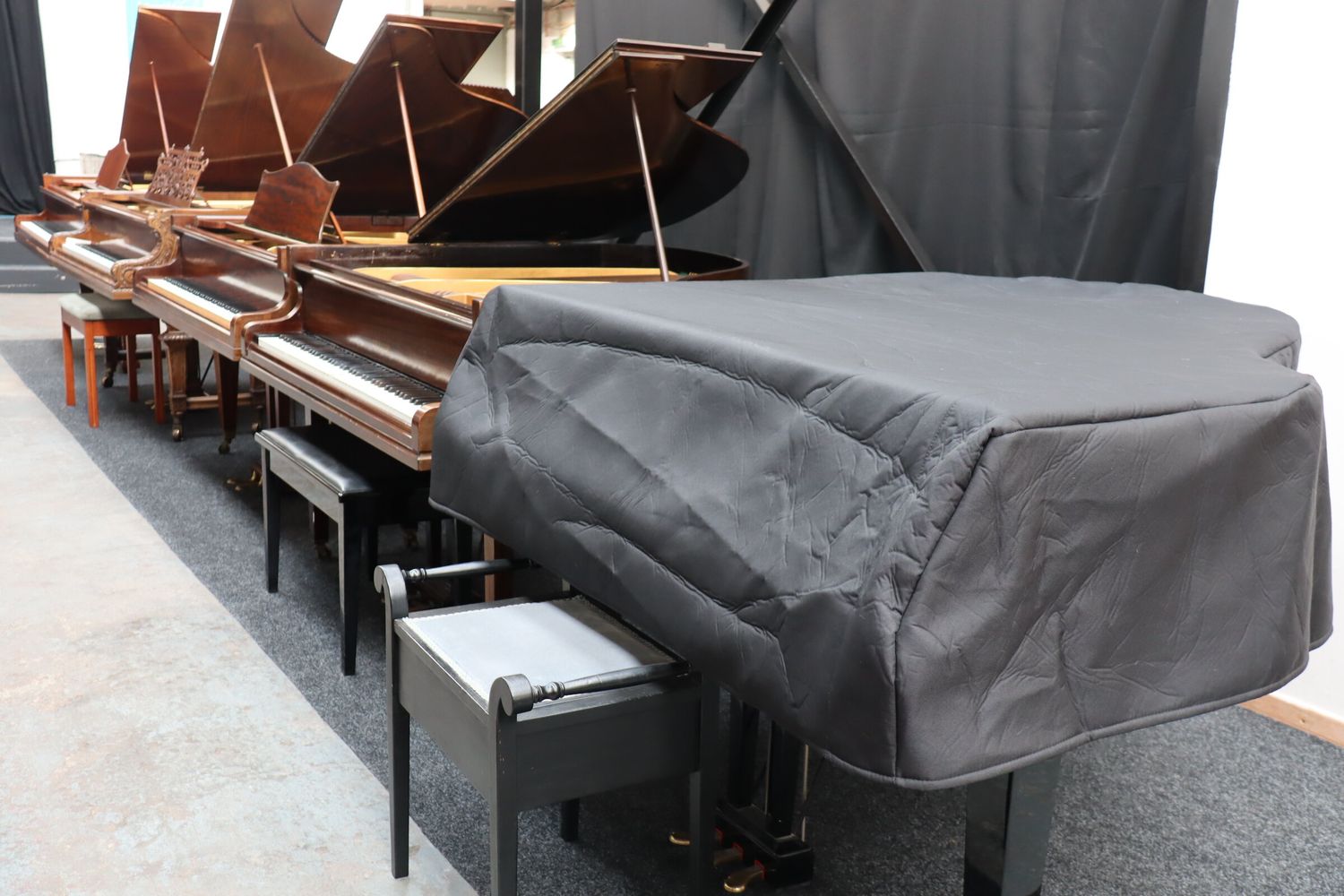Home>Instruments>Piano>How To Use Piano Hinges


Piano
How To Use Piano Hinges
Published: February 10, 2024
Learn how to use piano hinges to create seamless and sturdy joints for your woodworking projects. Discover tips and techniques for installing and maintaining piano hinges with ease.
(Many of the links in this article redirect to a specific reviewed product. Your purchase of these products through affiliate links helps to generate commission for AudioLover.com, at no extra cost. Learn more)
Table of Contents
Introduction
Introduction
The piano hinge, also known as a continuous hinge, is a versatile and durable hardware component that finds widespread use in various applications. Its unique design and robust construction make it an ideal choice for projects requiring seamless and secure movement, such as furniture, cabinets, and musical instrument lids. In this article, we will explore the intricacies of piano hinges, including their types, selection criteria, installation process, and valuable tips for optimal usage.
Piano hinges have been a staple in carpentry and woodworking for centuries, owing to their ability to provide consistent support and smooth operation. Whether you are a seasoned craftsman or a DIY enthusiast, understanding how to effectively utilize piano hinges can significantly elevate the quality and functionality of your projects.
Join us as we delve into the world of piano hinges, unraveling their diverse applications and shedding light on the best practices for integrating them into your woodworking endeavors. Whether you're embarking on a new project or seeking to enhance existing creations, mastering the art of using piano hinges can unlock a world of possibilities for seamless and enduring design solutions.
What is a Piano Hinge?
A piano hinge, often referred to as a continuous hinge, is a long, narrow hinge consisting of two interlocking metal strips joined by a central pin. This design allows for a full range of motion along the entire length of the hinge, making it an ideal choice for applications requiring smooth and consistent movement. The name “piano hinge” originates from its prevalent use in the construction of piano lids, where seamless and sturdy operation is paramount.
One of the defining features of a piano hinge is its continuous and uniform appearance when installed, as it runs the entire length of the object to which it is affixed. This characteristic not only contributes to a streamlined aesthetic but also ensures even weight distribution and enhanced structural integrity. Piano hinges are commonly crafted from durable materials such as stainless steel, brass, or aluminum, making them resilient to wear, corrosion, and environmental factors.
These hinges are renowned for their ability to support heavy loads and endure frequent use without compromising functionality. Their robust construction and smooth pivoting motion make them suitable for a wide array of applications, including furniture, cabinetry, toolboxes, and industrial equipment. Additionally, piano hinges are favored in architectural and marine settings, where reliability and longevity are paramount considerations.
Furthermore, the versatility of piano hinges extends beyond traditional woodworking and metalworking domains, as they are also utilized in the design of flight cases, medical equipment, and a myriad of specialized enclosures. Their adaptability to various materials and configurations makes them a go-to solution for engineers, designers, and craftsmen seeking a dependable and unobtrusive hinge option.
Next, we will explore the diverse types of piano hinges available, each tailored to specific applications and installation requirements.
Types of Piano Hinges
Piano hinges are available in a range of configurations to accommodate diverse functional and aesthetic needs. Understanding the distinct characteristics of each type enables craftsmen and designers to select the most suitable hinge for their specific applications. Here are some common variations of piano hinges:
- Standard Piano Hinges: This traditional type of piano hinge features a uniform width and barrel knuckles along its entire length. It is widely utilized in woodworking, furniture construction, and industrial enclosures due to its reliable performance and straightforward installation.
- Continuous Geared Hinges: Also known as “continuous hinges with gear,” this type incorporates interlocking gears along the hinge’s length, providing enhanced security and resistance to tampering. Continuous geared hinges are often employed in high-security environments, such as banks, government facilities, and critical infrastructure.
- Concealed Piano Hinges: Concealed piano hinges, as the name suggests, are designed to remain hidden from view when installed. They are favored for applications where a seamless and unobtrusive appearance is desired, such as in luxury furniture, architectural millwork, and high-end cabinetry.
- Decorative Piano Hinges: These hinges feature ornate patterns, intricate engravings, or decorative finishes, adding a touch of elegance and visual appeal to the objects they adorn. Decorative piano hinges are often employed in antique restoration, custom furniture, and specialty woodworking projects.
Each type of piano hinge offers unique advantages, ranging from enhanced security and aesthetics to seamless integration with various materials and design styles. By considering the specific requirements of a project, craftsmen can make informed decisions when selecting the most suitable piano hinge type for their creations.
Now that we’ve explored the diverse types of piano hinges, the next section will delve into the essential considerations for choosing the right piano hinge for a given application.
Choosing the Right Piano Hinge
When selecting a piano hinge for a particular application, several key factors should be taken into consideration to ensure optimal performance and longevity. By carefully evaluating the following aspects, craftsmen and designers can make informed decisions when choosing the most suitable piano hinge for their projects:
- Material: Piano hinges are available in various materials, including stainless steel, brass, aluminum, and steel. The choice of material should align with the environmental conditions, load-bearing requirements, and aesthetic preferences of the application. For instance, stainless steel piano hinges offer exceptional corrosion resistance, making them ideal for marine and outdoor applications, while brass hinges are favored for their classic appearance and durability.
- Load Capacity: Understanding the weight and stress that the hinge will bear is crucial in selecting a piano hinge with an appropriate load capacity. For heavy-duty applications such as large cabinet doors or equipment enclosures, hinges with higher load-bearing capabilities are essential to ensure long-term reliability and smooth operation.
- Size and Dimensions: The length, width, and thickness of the piano hinge should be compatible with the dimensions of the object it will be affixed to. Careful measurements and alignment are vital to prevent misalignment or strain on the hinge, which can lead to premature wear and compromised functionality.
- Finish and Aesthetics: The finish of the piano hinge, whether it’s polished, brushed, or coated, should harmonize with the overall design and aesthetic of the project. Additionally, considering the visibility of the hinge and the desired visual impact is crucial, especially in applications where the hinge will be exposed.
- Installation Requirements: Some applications may necessitate specific installation considerations, such as the need for concealed hinges, security features, or specialized mounting configurations. Understanding the installation requirements and constraints will guide the selection of a piano hinge that seamlessly integrates with the project.
By carefully evaluating these factors and consulting with industry experts or suppliers, craftsmen and designers can confidently choose the right piano hinge that aligns with the functional, aesthetic, and operational demands of their projects. In the following section, we will explore the step-by-step process of installing a piano hinge with precision and ease.
Installation Process
The successful installation of a piano hinge is pivotal in ensuring the longevity and functionality of the application it serves. Whether it’s a cabinet door, a musical instrument lid, or an industrial enclosure, following a precise installation process is essential for seamless operation. Here’s a step-by-step guide to installing a piano hinge with accuracy and efficiency:
- Prepare the Hinge and Object: Lay the hinge alongside the edge of the object to which it will be attached, ensuring that it aligns perfectly and spans the entire length. Mark the locations of the screw holes on both the hinge and the object, using a pencil or a scribe, to guide the drilling process.
- Drill Pilot Holes: Using an appropriate-sized drill bit, create pilot holes at the marked locations on both the hinge and the object. Pilot holes prevent the wood or metal from splitting and facilitate the insertion of screws, ensuring a secure and flush fit.
- Align and Secure the Hinge: With the assistance of a partner or a clamp to hold the hinge in place, align the pilot holes and affix the hinge to the object using suitable screws. Ensure that the hinge remains straight and level during the fastening process to prevent misalignment.
- Test the Movement: After securing the hinge, open and close the object to verify the smooth operation and alignment of the hinge. Make any necessary adjustments to the screws or hinge positioning to achieve optimal movement and clearance.
- Final Checks and Finishing: Inspect the installed hinge for any gaps, misalignments, or protruding screws. Make any final adjustments and ensure that the hinge operates smoothly and securely. If necessary, apply a protective finish or lubricant to the hinge to enhance its durability and performance.
Following these steps will result in a professionally installed piano hinge that provides seamless and reliable functionality, contributing to the overall quality and longevity of the project. In the next section, we will share valuable tips for using piano hinges effectively and maintaining their optimal performance over time.
Tips for Using Piano Hinges
Mastering the art of using piano hinges entails not only understanding their installation process but also implementing best practices to maximize their functionality and longevity. Here are valuable tips for effectively using piano hinges in various applications:
- Regular Maintenance: Periodically inspect the piano hinges for signs of wear, corrosion, or misalignment. Lubricate the hinge mechanism to ensure smooth operation and prevent premature deterioration.
- Load Distribution: When designing or retrofitting an application with a piano hinge, consider the distribution of weight and stress along the hinge to prevent undue strain and potential failure. Utilize multiple hinges for larger or heavier lids and doors to evenly distribute the load.
- Alignment and Clearance: Ensure that the hinge is meticulously aligned and positioned to provide adequate clearance for the object’s movement. Misaligned hinges can lead to binding, uneven wear, and compromised functionality.
- Security Considerations: In applications requiring enhanced security, such as equipment enclosures or access panels, opt for continuous geared piano hinges to deter tampering and unauthorized access.
- Finishing and Protection: Apply appropriate finishes or coatings to the piano hinge to safeguard it against environmental elements and corrosion, especially in outdoor or marine applications. Choose finishes that complement the overall aesthetic of the project.
- Customization and Adaptation: Explore customized piano hinge options to tailor the hinge’s appearance and functionality to specific project requirements. Custom lengths, hole patterns, and finishes can align the hinge seamlessly with the project’s design intent.
By incorporating these tips into the utilization and maintenance of piano hinges, craftsmen and designers can optimize the performance and durability of their projects, ensuring a seamless and enduring user experience. In the concluding section, we will summarize the key insights and benefits of effectively using piano hinges in various woodworking and construction endeavors.
Conclusion
In conclusion, the piano hinge stands as a timeless and indispensable component in woodworking, furniture construction, and a myriad of industrial and architectural applications. Its continuous and robust design, coupled with its versatility and enduring functionality, makes it a cornerstone of seamless movement and structural reliability.
By understanding the diverse types of piano hinges and the essential considerations for selecting the right hinge for a given application, craftsmen and designers can elevate the quality and performance of their projects. The installation process, when executed with precision and attention to detail, ensures the seamless operation and longevity of the hinge, contributing to the overall success of the application.
Moreover, integrating valuable tips for using piano hinges effectively, such as regular maintenance, load distribution, and security considerations, empowers craftsmen to harness the full potential of these hinges while safeguarding their lasting performance.
Whether it’s a grand piano lid, a cabinet door, or an industrial enclosure, the piano hinge serves as a testament to the marriage of form and function, offering a seamless and enduring solution for applications requiring continuous and reliable movement. Embracing the art of using piano hinges not only enhances the craftsmanship and functionality of projects but also elevates the user experience through seamless and enduring design solutions.
As craftsmen and designers continue to harness the timeless appeal and functionality of piano hinges, these enduring hardware components will undoubtedly remain a symbol of craftsmanship, reliability, and seamless operation in the ever-evolving landscape of woodworking and construction.











